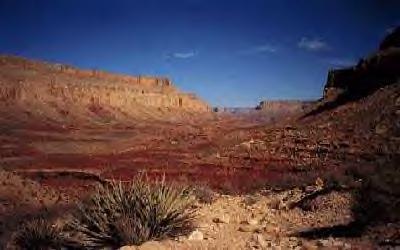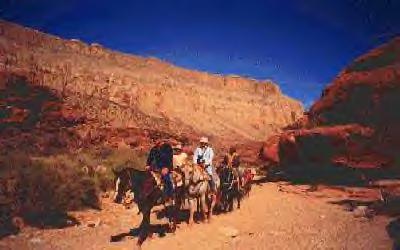|
|
Havasupai Tribe Joins the 21st Century
by Gary Fox, Public Affairs Northern Arizona University
Photos courtesy Northern Arizona University
|
It's a blessed way of life and a barrier for the future of the Havasupai Tribe. This small, close-knit tribe of 500 mothers, fathers, aunts, uncles and cousins lives on a 500-acre reservation at the bottom of one of arms of the Grand Canyon. It's a place where the time line of their ancestors and the canyon run parallel. Steep walls climb 3,000 feet from the verdant floor of the canyon where the bluish-green water of Havasupai Creek ambles toward the Colorado River, often spilling over towering cliffs producing spectacular torrents of angry white water. As the sun arcs its way across the sky, the red walls in the canyon change hues: purples, oranges and golds. Faces seemingly appear in the canyon walls -- ancestors, tribal members believe, showing the way for that day or for a lifetime. This tribe has had better days; it has had worse days. At the turn of the 20th century, the outside world altered the way of life for the Havasupai Tribe. The tribe had 2,000 members. Hunters and gatherers scoured the plateau above the canyon for hundreds of miles seeking deer, antelope, elk, collecting pinon nuts to sustain the tribe during winter. When the Grand Canyon became a national park, things changed, drastically. They were restricted to the small plot of land of their ancestors. The tribe no longer was allowed to hunt and gather on the plateau. If they did, penalties were severe. By 1950, the tribe faced extinction; only 200 members were left. In 1970, the tribe was given a token parcel of land on the plateau where they could hunt and gather from the earth. After 70 years of not being allowed to hunt, the tradition had not been handed down from generation to generation and was lost. Today, the reservation cannot sustain any more people, but it is a young tribe, a growing tribe. Sixty percent of today's tribe is 18 years old or younger. Chronic diseases killed most of the older members. There is no room to construct more homes or to expand existing leach fields for septic systems.
Health care is provided by the Arizona Department of Public Health. But health care workers are viewed as outsiders and it takes time for outsiders to be accepted. Recently, health care workers scheduled mammograms for tribal women over age 35. Thirty-seven appointments were made; six were kept. Jobs and poverty are at opposing ends of the scale, and poverty weighs heavily on the minds of tribal leaders. Some have tried to adapt and survive in the outside world, most return to Supai, to home. Education alone does not prepare the young for life outside the time-honored walls of their ancestral home. Children from eighth grade on are educated at boarding schools across the country. For the most part, boarding school has not been a positive experience. Due to availability, rarely are two students sent to the same school. The children are cut off from family and friends, alone in a new world. They are ill prepared to cope with the world above the rim of the canyon. At the turn of the 21st century, the outside world again has altered the Havasupai Tribe's way of life -- this time with the blessing of the tribal council. Today, six gray high-speed wireless Internet satellite dishes sit atop various community buildings in Supai, connecting the tribe to the outside world. In a project whose parties were brought together by Northern Arizona University, each of the six stations includes small-dish satellite equipment with a single computer, monitor and two-way Internet service through StarBand in league with EchoStar and Microsoft. NAU has long been a national leader in providing distance learning opportunities through interactive television, web-based courses, NAU Online and Universityhouse, NAU's satellite course delivery system with EchoStar and the Dish Network. "What these satellite dishes represent is a turning point for our tribe," said Sally Tilousi, director of the Havasupai Head Start program. "These satellite dishes are going to change and improve our tribe. "It means we can communicate with the outside world. We can communicate with other school systems for educational resources. And we can actively pursue other resources for our tribe. "Internet capabilities will improve our community," she said. "This will open the door to unlimited educational opportunities. Access to the world, access to education will improve the community. "Our boarding school students can communicate with family and friends at home and at other boarding schools with e-mail. Those who have lived here do not know what it is like to communicate instantly via e-mail. "Right now, only two people from our community have college degrees. By 2005, many more will have college degrees," she said. Tilousi was born and raised in Williams, 70 miles south of the tribal homelands. She earned a degree in nursing from Northern Arizona University. She was recently recognized as a distinguished alumna from NAU. Over the years she had visited her ancestral lands, but it wasn't until 1995 when she moved home. "It's where I was supposed to be," she said. "It was my calling to come home and be with my people.
"The reality of our young people staying here is slight. Reality is preparing them for the outside world because there are not a lot of job opportunities down here." The NAU Foundation funded the six Internet stations as a pilot project. "I'm glad NAU has risen to this challenge. They have said they will help with fees, but we need more," she said. "We need more support, more tutors, more proctors. We will need more intensive help. She said the youth are ill prepared for college. "Because of the learning curve, being able to pass a college course will be difficult. Our people are not assertive to ask for clarification if they do not understand the lesson. They will need to have someone in the television class whom they can ask for help when they don't understand. "Our people are smart, they just haven't had the background to be prepared." "We need human beings to help our kids apply for scholarships, to apply for admissions and financial aid, accessing the system. We need long-term assistance." "The children are our only hope for the future of this tribe," Tilousi said. "It's going to take awhile for this project to make a difference. I want to see them succeed." Havasupai Havasupai Tribal Council Southwest Indian
Peoples: Havasupai |
|
|
| Canku Ota is a free Newsletter celebrating Native America, its traditions and accomplishments . We do not provide subscriber or visitor names to anyone. Some articles presented in Canku Ota may contain copyright material. We have received appropriate permissions for republishing any articles. Material appearing here is distributed without profit or monetary gain to those who have expressed an interest. This is in accordance with Title 17 U.S.C. section 107. |
|
Canku Ota is a copyright of Vicki Lockard and Paul Barry. |
|
 Isolation.
Isolation. Food, clothes
and other necessities are taken into the canyon by helicopter or by packhorses and mules. There are no cars in
the canyon and there are only a handful of unreliable phones. Mail is delivered almost daily by horseback.
Food, clothes
and other necessities are taken into the canyon by helicopter or by packhorses and mules. There are no cars in
the canyon and there are only a handful of unreliable phones. Mail is delivered almost daily by horseback. "It's
another world here. This is a serene, beautiful community to live in. Isolation is a blessing, but it's also a
barrier.
"It's
another world here. This is a serene, beautiful community to live in. Isolation is a blessing, but it's also a
barrier.